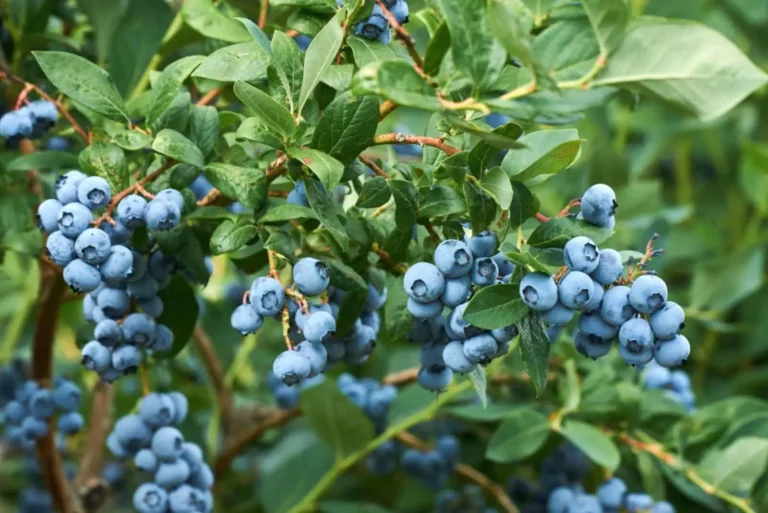Welcome to the world of Blueberries (Vaccinium corymbosum)! This deciduous shrub native to North America, has gained immense popularity for its delectable taste and numerous health benefits.
Its name, quite fittingly, comes from the vibrant blue hue of its berries. With its luscious green leaves and delicate white blossoms, the blueberry plant adds a touch of natural beauty to any garden or landscape.
While it requires some effort to care for these plants, the reward of a bountiful harvest and the joy of nurturing these vibrant berries make it all worthwhile.
Most common Blueberry varieties:
- Blueray
- Legacy
- Pink Icing
- Top Hat
- Biloxi
- Bluecrop
Care
You can keep your blueberry shrub happy if you pay attention to these requirements:
- Soil: When it comes to soil, blueberries demand a highly acidic environment, with a pH range of 4.0 to 5.2. Rich in organic matter, sandy soil is preferable over heavy clay, and raised beds offer better control over soil composition and pH. Adding mulch, ( e.g.: evergreen wood chips), helps you to maintain the right soil acidity.
- Light: Blueberry plants thrive in bright sunlight, requiring a minimum of 6 to 8 hours of direct exposure daily for optimal growth and fruit production.
- Water: Watering deeply once a week, ensuring a couple of inches of water, is crucial for the shallow-rooted blueberries, with automatic irrigation systems offering consistent moisture.
- Temperature: Blueberry bushes have temperature preferences based on their species, with traditional highbush types favoring cold winters and humid air, while Southern variants cannot tolerate freezing temperatures and benefit from protection against drying winds.
Propagation
If you’re looking to expand your blueberry plant collection without breaking the bank, propagating them from cuttings is a fantastic option. It not only saves money but also helps thin out mature plants. Softwood cuttings should be taken in early spring, while hardwood cuttings are best harvested in late winter. Here’s how it’s done:
- Select a healthy branch and trim the last five inches, keeping only the top two or three leaves.
- Apply a rooting hormone to the cut end.
- Plant the cutting in a moistened soilless potting mix, using a small container. Find a warm room with stable temperatures to place the container, avoiding drafts.
- Keep the cutting in bright, indirect light, ensuring the growing medium remains moist but not waterlogged. It may take a few months for the cutting to establish roots.
- Once new leaves emerge and the cutting shows resistance when gently pulled (indicating root growth), it’s ready for planting in the garden. For hardwood cuttings, wait until spring to transplant them outdoors.
Pruning
When it comes to pruning your blueberry bush, there are various techniques to consider.
- Selective pruning involves removing specific branches, targeting dead or damaged ones to improve the plant’s overall structure and health.
- Thinning focuses on overgrown areas, enhancing airflow and boosting fruit production by reducing overcrowding.
- Rejuvenation pruning is ideal for mature plants, where old canes are removed at the base, allowing new shoots to thrive.
For young blueberry bushes, tip pruning is beneficial. By removing branch tips or terminal buds, lateral growth is encouraged, promoting their development.
Check out our full guide on Pruning Blueberries here!
Common Pests
Frequently Asked Questions
Blueberry plants thrive in full sun, requiring at least six to eight hours of direct sunlight daily. They prefer highly acidic soil with a pH range of 4.0 to 5.2, rich in organic matter. Adequate moisture, but not waterlogging, and protection from extreme temperatures and drying winds contribute to their optimal growth.
What is the best month to grow blueberries?
Generally, early spring is a suitable time to plant blueberries when the soil is workable and temperatures are mild. In most regions, planting blueberries in April or May provides a good balance between establishing the plants before summer heat and allowing them to grow before winter dormancy. October can also work.
What country is blueberry from?
Blueberries are native to North America, specifically originating from the United States and Canada. They have been cultivated and enjoyed for centuries in these regions before spreading to other parts of the world.
Are Blueberries toxic to Pets?
Blueberries are non-toxic to pets and humans. In fact, they are considered superfoods that are rich in antioxidants.


